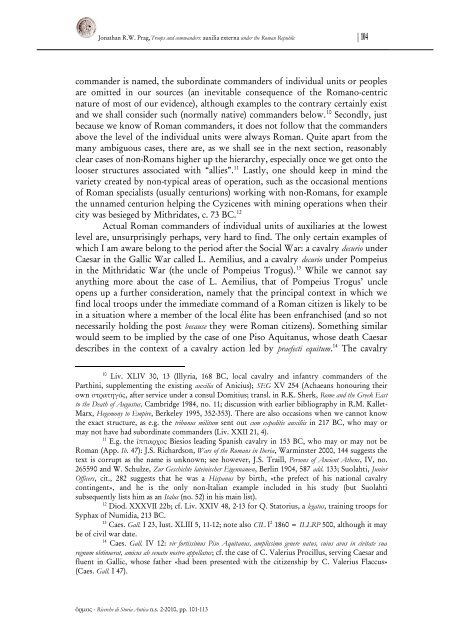n.s. 2-2010 - Societa italiana di storia militare
n.s. 2-2010 - Societa italiana di storia militare
n.s. 2-2010 - Societa italiana di storia militare
You also want an ePaper? Increase the reach of your titles
YUMPU automatically turns print PDFs into web optimized ePapers that Google loves.
Jonathan R.W. Prag, Troops and commanders: auxilia externa under the Roman Republic | 104<br />
commander is named, the subor<strong>di</strong>nate commanders of in<strong>di</strong>vidual units or peoples<br />
are omitted in our sources (an inevitable consequence of the Romano-centric<br />
nature of most of our evidence), although examples to the contrary certainly exist<br />
and we shall consider such (normally native) commanders below. 10 Secondly, just<br />
because we know of Roman commanders, it does not follow that the commanders<br />
above the level of the in<strong>di</strong>vidual units were always Roman. Quite apart from the<br />
many ambiguous cases, there are, as we shall see in the next section, reasonably<br />
clear cases of non-Romans higher up the hierarchy, especially once we get onto the<br />
looser structures associated with “allies”. 11 Lastly, one should keep in mind the<br />
variety created by non-typical areas of operation, such as the occasional mentions<br />
of Roman specialists (usually centurions) working with non-Romans, for example<br />
the unnamed centurion helping the Cyzicenes with mining operations when their<br />
city was besieged by Mithridates, c. 73 BC. 12<br />
Actual Roman commanders of in<strong>di</strong>vidual units of auxiliaries at the lowest<br />
level are, unsurprisingly perhaps, very hard to find. The only certain examples of<br />
which I am aware belong to the period after the Social War: a cavalry decurio under<br />
Caesar in the Gallic War called L. Aemilius, and a cavalry decurio under Pompeius<br />
in the Mithridatic War (the uncle of Pompeius Trogus). 13 While we cannot say<br />
anything more about the case of L. Aemilius, that of Pompeius Trogus’ uncle<br />
opens up a further consideration, namely that the principal context in which we<br />
find local troops under the imme<strong>di</strong>ate command of a Roman citizen is likely to be<br />
in a situation where a member of the local élite has been enfranchised (and so not<br />
necessarily hol<strong>di</strong>ng the post because they were Roman citizens). Something similar<br />
would seem to be implied by the case of one Piso Aquitanus, whose death Caesar<br />
describes in the context of a cavalry action led by praefecti equitum. 14 The cavalry<br />
10 Liv. XLIV 30, 13 (Illyria, 168 BC, local cavalry and infantry commanders of the<br />
Parthini, supplementing the existing auxilia of Anicius); SEG XV 254 (Achaeans honouring their<br />
own στρατηγός, after service under a consul Domitius; transl. in R.K. Sherk, Rome and the Greek East<br />
to the Death of Augustus, Cambridge 1984, no. 11; <strong>di</strong>scussion with earlier bibliography in R.M. Kallet-<br />
Marx, Hegemony to Empire, Berkeley 1995, 352-353). There are also occasions when we cannot know<br />
the exact structure, as e.g. the tribunus militum sent out cum expe<strong>di</strong>tis auxiliis in 217 BC, who may or<br />
may not have had subor<strong>di</strong>nate commanders (Liv. XXII 21, 4).<br />
11 E.g. the ἵππαρχος Biesios lea<strong>di</strong>ng Spanish cavalry in 153 BC, who may or may not be<br />
Roman (App. Ib. 47): J.S. Richardson, Wars of the Romans in Iberia, Warminster 2000, 144 suggests the<br />
text is corrupt as the name is unknown; see however, J.S. Traill, Persons of Ancient Athens, IV, no.<br />
265590 and W. Schulze, Zur Geschichte lateinischer Eigennamen, Berlin 1904, 587 add. 133; Suolahti, Junior<br />
Officers, cit., 282 suggests that he was a Hispanus by birth, «the prefect of his national cavalry<br />
contingent», and he is the only non-Italian example included in his study (but Suolahti<br />
subsequently lists him as an Italus (no. 52) in his main list).<br />
12 Diod. XXXVII 22b; cf. Liv. XXIV 48, 2-13 for Q. Statorius, a legatus, training troops for<br />
Syphax of Numi<strong>di</strong>a, 213 BC.<br />
13 Caes. Gall. I 23, Iust. XLIII 5, 11-12; note also CIL I 2 1860 = ILLRP 500, although it may<br />
be of civil war date.<br />
14 Caes. Gall. IV 12: vir fortissimus Piso Aquitanus, amplissimo genere natus, cuius avus in civitate sua<br />
regnum obtinuerat, amicus ab senatu nostro appellatus; cf. the case of C. Valerius Procillus, serving Caesar and<br />
fluent in Gallic, whose father «had been presented with the citizenship by C. Valerius Flaccus»<br />
(Caes. Gall. I 47).<br />
ὅρμος - Ricerche <strong>di</strong> Storia Antica n.s. 2-<strong>2010</strong>, pp. 101-113

















